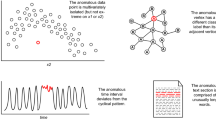Abstract
Benford’s Law gives the expected frequencies of the digits in tabulated data and asserts that the lower digits (1, 2, and 3) are expected to occur more frequently than the higher digits. This study tested whether the law applied to two large earth science data sets. The first test analyzed streamflow statistics and the finding was a close conformity to Benford’s Law. The second test analyzed the sizes of lakes and wetlands, and the finding was that the data did not conform to Benford’s Law. Further analysis showed that the lake and wetland data followed a power law. The expected digit frequencies for data following a power law were derived, and the lake data had a close fit to these expected digit frequencies.
The use of Benford’s Law could serve as a quality check for streamflow data subsets, perhaps related to time or geographical area. Also, with the importance of lakes as essential components of the water cycle, either Benford’s Law or the expected digit frequencies of data following a power law could be used as an authenticity and validity check on future databases dealing with water bodies. We give several applications and avenues for future research, including an assessment of whether the digit frequencies of data could be used to derive the power law exponent, and whether the digit frequencies could be used to verify the range over which a power law applies. Our results indicate that data related to water bodies should conform to Benford’s Law and that nonconformity could be indicators of (a) an incomplete data set, (b) the sample not being representative of the population, (c) excessive rounding of the data, (d) data errors, inconsistencies, or anomalies, and/or (e) conformity to a power law with a large exponent.
Similar content being viewed by others
References
Benford F (1938) The law of anomalous numbers. Proc Am Philos Soc 78(4):551–572
DeGroot M, Schervish M (2002) Probability and statistics, 3rd edn. Addison-Wesley, Reading
Diaconis P (1976) The distribution of leading digits and uniform distribution mod 1. Ann Probab 5(1):72–81
Drake PD, Nigrini MJ (2000) Computer assisted analytical procedures using Benford’s Law. J Account Educ 18(2):127–146
Hill TP (1995) Base-invariance implies Benford’s Law. Proc Am Math Soc 123(3):887–895
Kontorovich AV, Miller SJ (2005) Benford’s Law, values of L-functions, and the 3x+1 problem. Acta Arith 120(3):269–297
Lagarias J, Soundararajan K (2006) Benford’s Law for the 3x+1 function. J Lond Math Soc 74(2):273–288
Leemis LM, Schmeiser BW, Evans DL (2000) Survival distributions satisfying Benford’s Law. Am Stat 54(3):1–6
Lehner B, Döll P (2004) Development and validation of a global database of lakes, reservoirs and wetlands. J Hydrol 296(1–4):1–22
Ley E (1996) On the peculiar distribution of the US Stock Indices first digits. Am Stat 50(4):311–313
Newman MEJ (2005) Power laws, Pareto distributions and Zipf’s law. Contemp Phys 46(5):323–351
Nigrini MJ (1996) A taxpayer compliance application of Benford’s Law. J Am Tax Assoc 18:72–91
Nigrini MJ (2005) An assessment of the change in the incidence of earnings management around the Enron–Andersen episode. Rev Account Financ 4(1):92–110
Nigrini MJ, Mittermaier LJ (1997) The use of Benford’s Law as an aid in analytical procedures: Auditing. J Pract Theory 16(2):52–67
Pinkham RS (1961) On the distribution of first significant digits. Ann Math Stat 32(4):1223–1230
Raimi R (1969) The peculiar distribution of first digits. Sci Am 221(6):109–120
Raimi R (1976) The first digit problem. Am Math Mon 83(7):521–538
The Economist (2006) Scientific fraud: Egg on his face, 5 January 2006
Wallace WA (2002) Assessing the quality of data used for benchmarking and decision-making. J Gov Financ Manag 51(3):16–22
Author information
Authors and Affiliations
Corresponding author
Rights and permissions
About this article
Cite this article
Nigrini, M.J., Miller, S.J. Benford’s Law Applied to Hydrology Data—Results and Relevance to Other Geophysical Data. Math Geol 39, 469–490 (2007). https://doi.org/10.1007/s11004-007-9109-5
Received:
Accepted:
Published:
Issue Date:
DOI: https://doi.org/10.1007/s11004-007-9109-5




